The Weekly Leading Index (WLI) growth indicator of the Economic Cycle Research Institute (ECRI) is now at 1.0 as reported in today's public release of the data through March 30. This is the twelfth consecutive week of improving data for the Growth Index and the first postive reading since August 12th of last year. The underlying WLI also improved, increasing from an adjusted 125.8 to 126.5 (see the fourth chart below).
The "Yo-Yo Years"
Earlier this month ECRI posted a public commentary (March 22) with the intriguing title The Yo-Yo Years. The commentary is a version of Lakshman Achuthan's presentation at the Bloomberg Sovereign Debt Conference in Frankfurt, Germany, and is a must-read for anyone following the ECRI data.
Essentially Achuthan argues that we are entering an era of more frequent recessions as a result of two things: 1) declining economic trend growth and 2) increased cyclical volatility following the end of the Great Moderation (circa mid-1980s to 2007). The "we" in the sentence above is not only the US but also much of the developed world, especially Europe. Moreover, the idea of global "decoupling" is largely a myth because of the export dependence of most economies.
Particularly interesting is Achuthan's discussion of the Bullwhip Effect, "where small fluctuations in consumer demand growth get amplified up the supply chain into big swings in demand as we move away from the consumer." Achuthan goes on to explain the mechanics of amplification of the Bullwhip effect on more frequent recessions in developed countries to the countries that supply intermediate and crude goods.
Year-over-Year Growth in the WLI
Triggered by another ECRI commentary, Why Our Recession Call Stands, I'm now focusing initially on the year-over-year growth of the WLI rather than ECRI's previously favored, and rather arcane, method of calculating the WLI growth series from the underlying WLI (see the endnote below). Specifically the chart immediately below is the year-over-year change in the 4-week moving average of the WLI.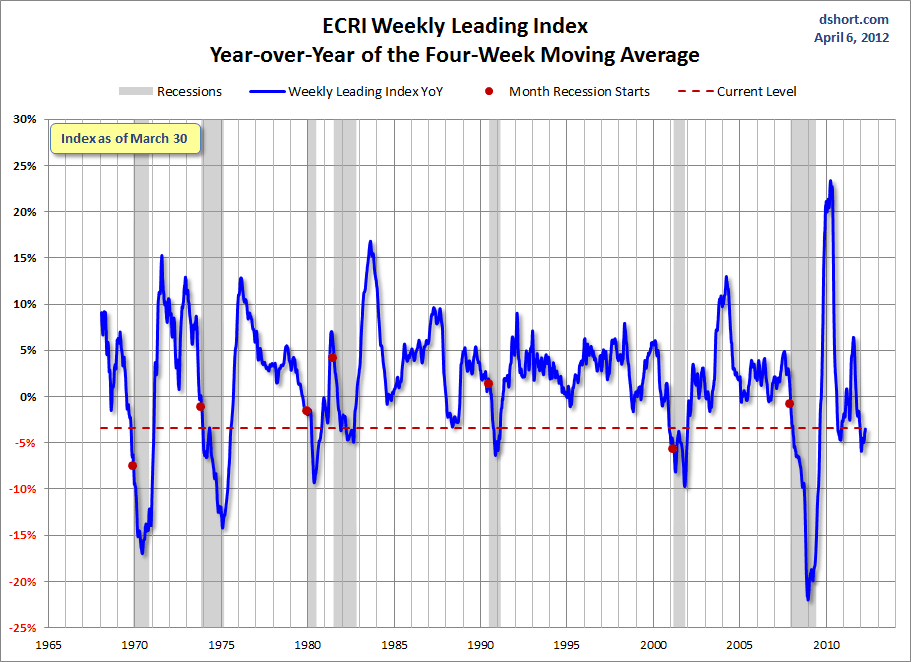
As the chart above makes clear, the WLI YoY is currently at a lower level than at the starting month for five of the seven recessions during the published series. Of course, the same can be said for its interim YoY trough in 2010. In any case, the behavior of this indicator over the next quarter or so will be especially interesting to watch.
The History of ECRI's Recession Call
On September 30th, ECRI publicly announced that the U.S. is tipping into a recession, a call the Institute had announced to its private clients on September 21st. Here is an excerpt from the announcement:
Early last week, ECRI notified clients that the U.S. economy is indeed tipping into a new recession. And there's nothing that policy makers can do to head it off.
ECRI's recession call isn't based on just one or two leading indexes, but on dozens of specialized leading indexes, including the U.S. Long Leading Index, which was the first to turn down - before the Arab Spring and Japanese earthquake - to be followed by downturns in the Weekly Leading Index and other shorter-leading indexes. In fact, the most reliable forward-looking indicators are now collectively behaving as they did on the cusp of full-blown recessions, not "soft landings." (Read the report here.)
For a close look at this movement of this index in recent months, here's a snapshot of the data since 2000. 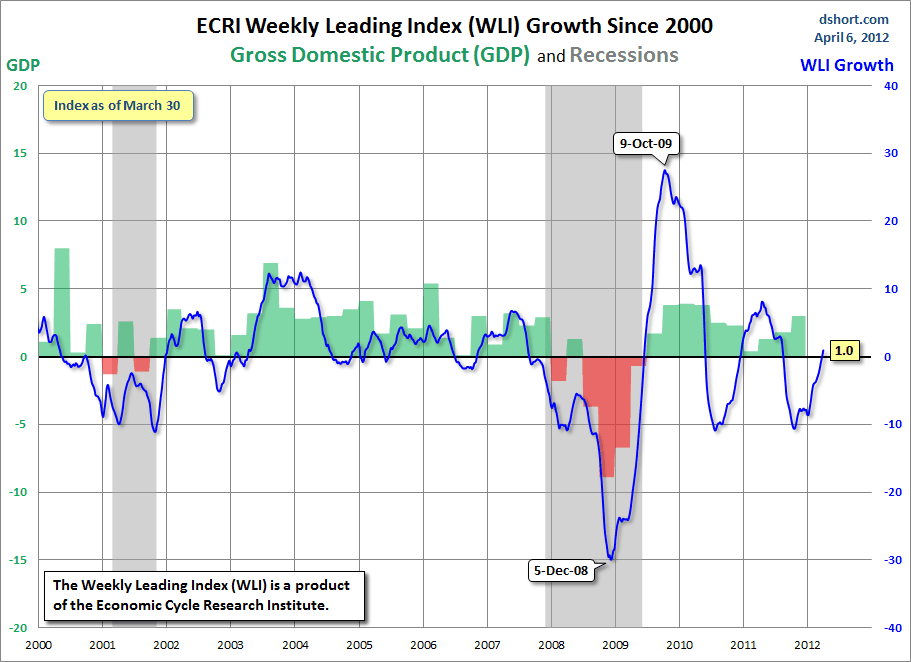
Now let's step back and examine the complete series available to the public, which dates from 1967. ECRI's WLI growth metric has had a respectable record for forecasting recessions and rebounds therefrom. The next chart shows the correlation between the WLI, GDP and recessions. 
A significant decline in the WLI has been a leading indicator for six of the seven recessions since the 1960s. It lagged one recession (1981-1982) by nine weeks. The WLI did turned negative 17 times when no recession followed, but 14 of those declines were only slightly negative (-0.1 to -2.4) and most of them reversed after relatively brief periods.
Three other three negatives were deeper declines. The Crash of 1987 took the Index negative for 34 weeks with a trough of -6.8. The Financial Crisis of 1998, which included the collapse of Long Term Capital Management, took the Index negative for 23 weeks with a trough of -4.5.
The third significant negative came near the bottom of the bear market of 2000-2002, about nine months after the brief recession of 2001. At the time, the WLI seemed to be signaling a double-dip recession, but the economy and market accelerated in tandem in the spring of 2003, and a recession was avoided.
The question had been whether the WLI decline that began in Q4 of 2009 was a leading indicator of a recession. The published index has never dropped to the -11.0 level in July 2010 without the onset of a recession. The deepest decline without a recession onset was in the Crash of 1987, when the index slipped to -6.8. ECRI's managing director correctly predicted that we would avoid a double dip. The positive GDP since the end of the last recession supports ECRI's stance.
The Certainty and Dramatic Language of ECRI's New Recession Call
What is particularly striking about ECRI's current recession call is the fervor and certainty of the language in the public press release:
Here's what ECRI's recession call really says: if you think this is a bad economy, you haven't seen anything yet. And that has profound implications for both Main Street and Wall Street.
Note the complete absence of wiggle room in the announcement, nor have there been any public communications from ECRI to qualify or soften its recession call. ECRI has put its credibility on the line. As I've said before, if the U.S. avoids a recession, ECRI's reputation will be permanently damaged.
A Look at the Underlying index
With the Growth Index showing so little change over the past several weeks, let's take a moment to look at the underlying Weekly Leading Index from which the Growth Index is calculated. The first chart below shows the index level.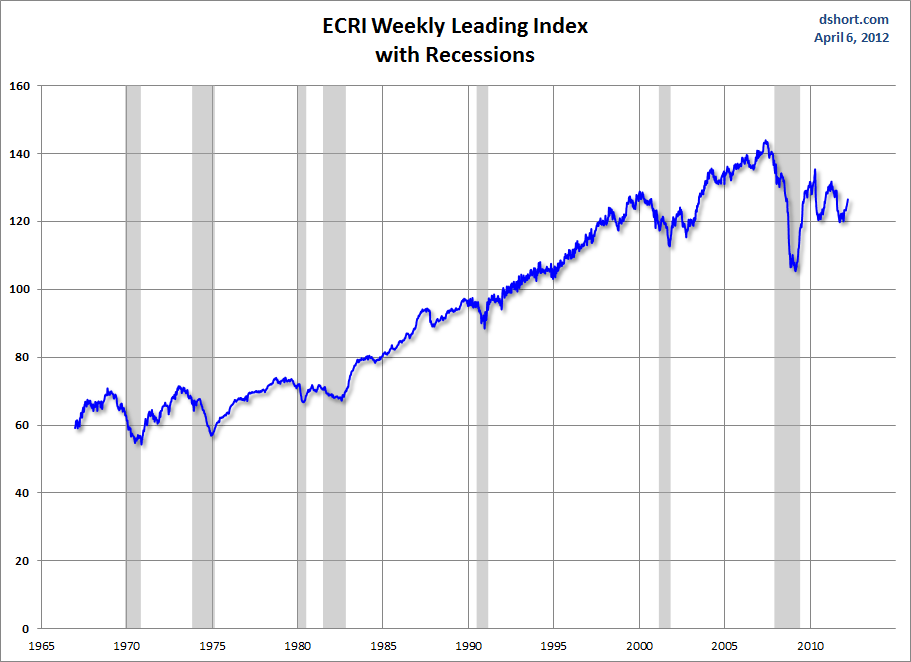
For a better understanding of the relationship of the WLI level to recessions, the next chart shows the data series in terms of the percent of the previous peak. In other words, a new weekly high registers at 100%, with subsequent declines plotted accordingly. 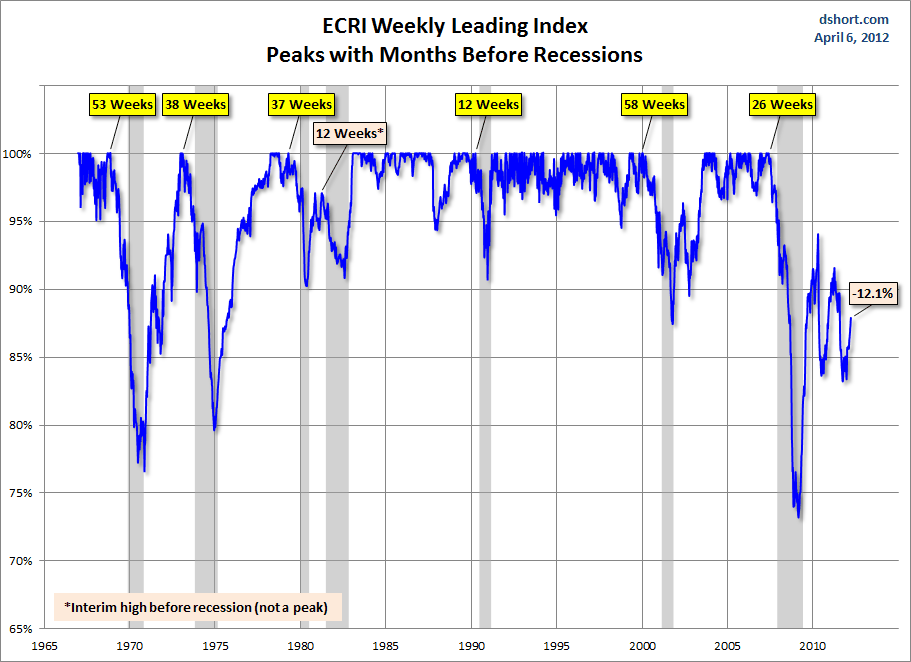
As the chart above illustrates, only once has a recession occurred without the index level achieving a new high -- the two recessions, commonly referred to as a "double-dip," in the early 1980s. Our current level is 14.5% off the most recent high, which was set 4.7 years ago. The longest stretch between highs was about 5.2 years from February 1973 to April 1978. But the index level rose steadily from the trough at the end of the 1973-1975 recession to reach its new high in 1978. The pattern we're now witnessing is quite different.
Additional Recent Analysis
Here are some links to some useful articles for evaluating the substance of the ECRI's controversial recession call:
- March 6: ECRI's Recession Call: "Is There Something Magic About 2 Percent?" Georg Vrba digs into ECRI's claims about the year-over-year growth rate of its indicators.
- March 3: The Elusive 2012 Recession: When Can We Expect It? Georg Vrba and Dwaine van Vuuren introduce the RecessionAlert.com website.
- February 21: Evaluating Popular Recession Indicators Georg Vrba offers a critique of three recession indicators, including ECRI's WLI and WLI Growth.
- February 17: No Wonder ECRI's Weekly Leading Index Data is Free Kishor Bhatia points out the remarkable similarity between the WLI and the S&P 500.
- February 14: Recession: Just How Much Warning is Useful Anyway? Dwaine van Vuuren questions the benefit of recession forecasts for portfolio management.
Earlier discussions of the ECRI recession call include these commentaries:
- January 18: Why the Average Investor Is Bamboozled by Recession Forecasts by Jeff Miller.
- January 17: Further Improving the Use of the ECRI WLI by Dwaine van Vuuren and Georg Vrba)
- January 10: Using the ECRI WLI to Flag Recessions by Dwaine van Vuuren
- January 3: US Recession - An Opposing View by Dwaine van Vuuren.
Here is Dwaine's snapshot of the WLI, which should be studied in the context of his expanded analysis at his RecessionAlert website: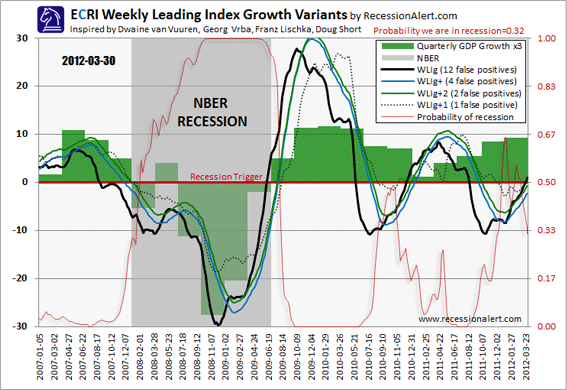
With regard to the latest ECRI update, Dwaine comments on a previous update:
The WLI growth (as published by ECRI) is exactly on zero from a revised -0.8 the prior week (it was -0.36 prior to revision last week.) We note the WLI was subject to downward revisions this week, going back 8 weeks. Nonetheless this is the 11th consecutive week of rises in the growth index. Barring further downward revisions and a rise in the WLI the WLIg is sure to breach the zero threshold. The WLIg+1 which is our preferred measurement, registered -0.26 from a revised -0.78 the prior week (-0.58 before the revision). We calculate real-time probability of recession with the WLI based on WLIg+1 and this registered 0.34 this week, versus 0.38 last week. It is looking like the WLI has posted its 2nd false positive since March 2009, but we need to wait for the growth metrics to rise above zero before having more conviction on this. RecessionAlert.com]
Note from dshort: I highly recommend reading the full commentary, which includes some additional fascinating charts.
Another Source for Recession Forecasts
For a carefully researched and frequently updated alternative perspective on recession risk, see the Recession Alert website maintained by Sharenet and PowerStocks Research.
But What About the 3.0 Q4 GDP?  Yesterday the BEA posted its Third Estimate of 3.0 for Q4 GDP, unchanged from the Second Estimate but up from 2.8 in the Advance Estimate. This is definitely above the conventional view of the economy on the threshold of a recession. ECRI itself did not offer a specific date for the start of the forecast recession. A general view is that ECRI's headlights shine about six months into the future, which would make Q1 2012 GDP a critical number for evaluating ECRI's stance. In his recent media appearances, ECRI's Achuthan has said that his company's date for the start of the recession extends though the first half of 2012.
Yesterday the BEA posted its Third Estimate of 3.0 for Q4 GDP, unchanged from the Second Estimate but up from 2.8 in the Advance Estimate. This is definitely above the conventional view of the economy on the threshold of a recession. ECRI itself did not offer a specific date for the start of the forecast recession. A general view is that ECRI's headlights shine about six months into the future, which would make Q1 2012 GDP a critical number for evaluating ECRI's stance. In his recent media appearances, ECRI's Achuthan has said that his company's date for the start of the recession extends though the first half of 2012.
The U.S. has had eleven recessions since the earliest quarterly GDP calculations, which began in 1948. In the month declared by the National Bureau of Economic Research (NBER) as the beginning of the recession, quarterly GDP for that month has only been negative four times. In fact, three of the six positive GDP recession starts were at GDP levels higher than the 3.0 of Q4 2011.
ECRI doesn't provide the general public with the analytical details behind its calls, but the Hoisington Investment Management Q4 Reportalso makes a 2012 recession call accompanied by an extended economic analysis that includes several key topics:
- soaring debt-to-GDP
- contractionary fiscal and monetary policies
- anticipated decline in exports
- a weakened consumer
- capital spending cutbacks
See also the Advisor Perspectives interview with Lacy Hunt, Hoisington's executive vice president, for a reassertion of their recession call with some additional explanation for their views.
Note: How to Calculate the Growth series from the Weekly Leading Index
ECRI's weekly Excel spreadsheet includes the WLI and the Growth series, but the latter is a series of values without the underlying calculations. After a collaborative effort by Franz Lischka, Georg Vrba, Dwaine van Vuuren and Kishor Bhatia to model the calculation, Georg discovered the actual formula in a 1999 article published by Anirvan Banerji, the Chief Research Officer at ECRI: The three Ps: simple tools for monitoring economic cycles - pronounced, pervasive and persistent economic indicators.
Here is the formula:
"MA1" = 4 week moving average of the WLI
"MA2" = moving average of MA1 over the preceding 52 weeks
"n"= 52/26.5
"m"= 100
WLIg = [m*(MA1/MA2)^n] – m
